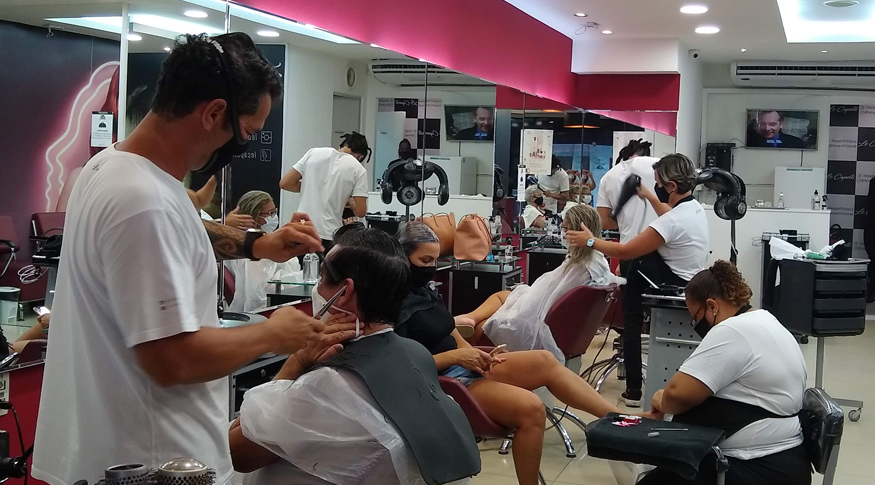Continuous PNAD
Unemployment drops to 10.5% in quarter ended in April
May 31, 2022 09h00 AM | Last Updated: June 02, 2022 06h50 PM

The unemployment rate stood at 10.5% in the quarter ended in April, the lowest for that quarter since 2015, when it was 8.1%. Compared to the previous quarter, the rate dropped 0.7 percentage points (pp), and, in the year, the drop was 4.3 pp. The data are from the Continuous National Household Sample Survey (Continuous Pnad), released today (May 31) by the IBGE.
The number of employed persons, of 96.5 million, is the highest in the time series, which started in 2012, and showed an increase of 1.1% compared to the quarter from November to January and 10.3% compared to the same quarter of the previous year. That represents an increase of 1.1 million persons in the quarter and of 9 million employed persons in the year.
The unemployed population, estimated at 11.3 million persons dropped 5.8% over the previous quarter, which represents 699 thousand less persons). In the year, the drop was of 25.3%, 3.8 million less unemployed persons.
“This quarter, we are facing the retreat of the unemployment rate, which has been falling since the quarter ended in July 2021 mostly due to the advance of the employed population in the las quarters”, says Adriana Beringuy, coordinator of the household sample surveys of the IBGE.
She adds that the increases in the employment took place in the groups of Transportation, storage and mailing, Public administration, defense, social security, education, human health and social services and Other services. The other groups remained stable.
“The group Public administration, defense, social security, education, human health and social services was leveraged by the growth in education which includes both the private and the public systems. In other services, the highlight is the rise of beautification services, such as hairdressers,manicure and esthetician”, explains the researcher.
The number of workers with a formal labor contract in the private sector was 35.2 million persons, having increased 2.0% (690 thousand persons against the previous quarter and 11.6% (an increase by 3.7 million persons) in the annual comparison.
“This quarter keeps the recovery trend of the formal labor contract, with several activities recording expansion, mainly in information, communication and financial, real estate, professional and administrative activities”, explains Ms. Beringuy.
She highlights that, in the comparable series, this is the greater contingent with a labor contract since the quarter ended in April 2016 and the fourth consecutive significative expansion both in the quarter and in the year.
All the other employment types, as workers without a labor contract in the private sector, self-employed and employers, among others, held steady. Thus, the informality rate fell from 40.4%, in the previous quarter, to 40.1% in the employed population, totaling 38.7 million informal workers.
Earnings fall 7.9% in the year
The usual real earnings, of R$ 2,569 in the quarter ended April, recorded stability against the previous quarter and decreased by 7.9% against the same quarter a year ago.
Ms. Beringuy explains that the expansion of formality did not mean earnings growth: “Although there has been growth in formality, no expansion was seen in the real average earnings of workers with a formal labor contract in the private sector. In addition, there was decrease in the income of the public sector”, she says.
The usual real wage bill (R$ 242.9 billion) grew over the previous quarter and stood stable in the annual comparison.
“In the quarter overview, the wage bill increased due to the expansion of employment. IN the year, although there has been a considerable growth of the employed population, there was retraction in the earnings, making the wage bill stable despite the greater number of employed persons”, claims the researcher.
More about the survey
The Continuous PNAD is the main instrument to monitor workforce in Brazil. The survey sample per quarter corresponds to 211 thousand households surveyed in Brazil. Nearly two thousand interviewers work in the survey in 26 states and in the Federal District, integrated to the data collection network of more than 500 IBGE branches.
Due to the Covid-19 pandemic, the IBGE implemented data collection by telephone on March 17, 2020. In July 2021, face-to-face data collection was resumed. The id of the interviewers can be confirmed at the Answering the IBGE website or through the Call Center (0800 7218181) by checking their ID numbers, which can be requested by the informants.
See PNAD data at Sidra.




















